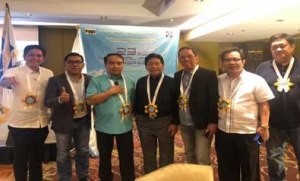Philippines strengthens skills of agricultural workers, sends 17 state colleges to tech-voc training mission in Malaysia

April 10, 2019
The Philippines has beefed up effort to strengthen skills of agricultural workers as it sent 17 state universities and colleges (SUC) to a Malaysian regional meeting on technical-vocational educational training (TVET) that can support local farm sector development.
As part of helping enhance skills of agricultural workers, the Southeast Asian Regional Center for Graduate Study & Research in Agriculture (SEARCA) has supported sending 36 representatives from 17 SUCs in support of labor exchange in Southeast Asia.
Southeast Asian ministers are investing in more TVET jobs program, aligning each other’s program for standardization and labor exchange.
SEARCA is also carrying out a research on competency certification for agricultural workers to promote TVET in agriculture.
The Philippine government is supporting technical-vocational (tech-voc) jobs having ratified last month the Tulong Trabaho Act (Republic Act 11230). It establishes a Philippine Labor Force Competencies Competitiveness PRogram. Training fees for tech-voc jobs will be free under the law.
Government is also strengthening capacity development for agricultural workers in TVET as studies have shown that “excellent agricultural vocational schools persist in serving the rural community and strengthen school enterprise cooperation.”
A World Bank study showed that agricultural tech-voc schools in China have popularized new technology in agriculture and production methods and have optimized planting techniques.
“The school has dispatched teachers to train farmers in cultivation, pest control and preservation,” according to the World Bank’s “Case Study of Excellent TVET Institutions.”
TVET agricultural schools also help construct pilot farms.

TVET participants
The country’s delegates to the TVET meeting come from Bicol State College of Applied Science and Technology, Bulacan State University, Camarines Norte State College, Central Bicol State University of Agriculture, Central Luzon State University, Central Mindanao University, Don Mariano Marcos Memorial State University, Guimaras State College, Iloilo Science and Technology University, Iloilo State College of Fisheries, Lyceum Northwestern University, Mariano Marcos State University, Mindoro State College of Agriculture of Technology, Nueva Ecija University of Science and Technology, Pangasinan State University, President Ramon Magsaysay State University, Saint Louis University, Tarlac Agricultural University, Trimex Colleges Inc., University of Mindanao, and University of the Immaculate Conception.
There are also representatives from the Technical Education and Skills Development Authority (TESDA) at the conference in Ipoh, Malaysia which was convened by the Southeast Asian Ministers of Education Organization (SEAMEO) last March 26-27.
The TVET program of Southeast Asia aims to enhance the internationalization and partnership of TVET institutions and promote global competitiveness and 21st century skills of TVET students.
SEAMEO is also developing a common regional policy framework for labor,
skills, and learner mobility that will allow competent Filipino farm workers to work in the neighboring countries.

World Bank study
The TVET agricultural schools cited in the World Bank study built farms in the rural areas, training centers for seed production, research laboratories on campus and training centers outside the school. These also formulated training courses with programs reflecting efficient production systems in enterprises.
For one, the Heilongjiang Nongken Vocational offered food safety and quality system training to companies and conducted research on the preservation of mashed potato.

Tech-voc jobs in agriculture
As there has been a decreasing enrolment in agricultural schools and a decreasing number of farm workers, the World Bank study has recommended the following to enhance training in tech-voc jobs:
1. Promote development of agricultural vocational education.
“Promoting the development of agricultural vocational education is closely linked to the development of regional economies in China. To support the country’s economic development goals, the government must continue to pursue agricultural modernization, which in turn will develop agricultural vocational education.”
2. Promote green and creative agricultural production which is now recognized by trade certification advocates globally.
3. Develop the processing industry of local agricultural products to increase added value.
4. Develop the agricultural cooperative model to support the farmers throughout the production process.
5. Enhance IT resources to provide on-line courses on agricultural on tech-voc training.
6. Develop the online market of agricultural products to promote their production, sales, branding and other related activities.
7. Enhance the attraction of Agriculture-related majors to raise awareness on the developing agriculture sector.
“Currently, the development of the agriculture industry is far beyond the traditional planting, and this new development requires a large number of excellent skilled workers.”
Tech-voc schools also need to integrate new agricultural trends and technology into their curriculum.
“Government also needs to increase public finance to improve learning conditions within agricultural vocational schools and between the schools and enterprises. The increase in teacher welfare and training will also do much to develop agricultural tech-voc education.”
SEA cooperation
Southeast Asian countries are collaborating on putting up policy reforms in tech-voc education even in agriculture, recognizing its unique role in rural development.
“All Southeast Asian countries have placed TVET in mainstream education because of its important role in the socio-economic development of a nation. In addition, TVET has been identified as one of the seven priority areas in education in Southeast Asia as agreed at the Strategic Dialogue of Education Ministers (SDEM).” (Growth Publishing for SEARCA-Melody M. Aguiba)
PHOTO CAPTION:
1 SEARCA agricultural competency working
2 SEA TVET
3 Filipino farm workers run harvesting machine
4 Farm technicians at IRRI




















